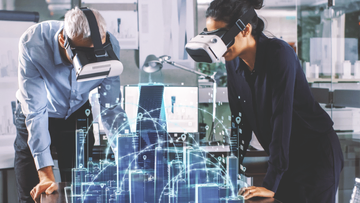Immersive Technology adoption in Oil & Gas Industry
Virtual reality and augmented reality are only now coming of age. Meanwhile, oil and gas have been major industries for over a century.
At first glance, it can be all too easy to wonder what these literal fossil industries have to gain from immersive technology. However, in many cases, it is the oldest profession that has the most to gain from the newest technologies.
Immersive Technology in Training
Oil and gas are valuable because they are volatile. Working with them is dangerous for workers and for the environment. As a result, extensive workplace training is important. The power industry is only one high-risk industry that has removed the danger from training by using immersive technology.
In order to provide the most accurate training possible, 3D Media specializes in rendering workspaces for virtual reality simulations. The studio works with companies to create tailored solutions for their needs using laser scanning and Photogrammetry. These advanced technologies allow a photorealistic and entirely accurate digital model of the actual work environment.
Another immersive technology company in the training field is TaleSpin. Where companies like 3D Media focus on “hard skills,” TaleSpin focuses on “soft skills” like communication. They have applications for things like task orientation but their real talent is in helping employees work with one another and with the public.
Immersive Technology in the Field
Not all immersive technology in the fuel industry is used for training purposes. A Polish company, Solution4Labs, works with a number of industries – including fuel and heavy industry. Their HoloLens application combines immersive technology with the Internet of Things, giving scientists access to new abilities and layers of information.
Printable QR codes placed on objects in the real world give researchers access to information that they can navigate hands-free. Voice commands allow them to move models and do calculations without taking their hands off of their work. They can even use the technology to videocall colleagues within the glasses. Users can even transfer information between lab equipment and the glasses for instantaneous and accurate records. Perhaps most importantly, the software can help them to access information like what to do in the case of a workplace emergency.
Virtual Reality and Augmented Reality Hardware Producers
Solutions4Labs, TaleSpin, and 3D Media all offer great software solutions. To use these tools, oil and gas companies need to invest in hardware as well. Fortunately, there’s no shortage of options.
One option has already been mentioned: HoloLens. The MR headset from Microsoft, is currently in its second iteration and is targeted primarily at enterprise. It’s favored by healthcare but comes with attachments to fit over hardhats as well.
Epson’s Moverio, another name that we’ve mentioned, has models that come with similar attachments. They also have a much larger selection of models with different software abilities and hardware options to fit different needs. In terms of factors like field-of-view, Epson isn’t the biggest player in the industry. However, Epson’s smaller and more versatile headsets are a better fit for most industries. The company also specializes in using immersive reality to control and interact with drones.
HoloLens and Epson both make Mixed Reality headsets for use in the field. However, there are other options. HTC’s VIVE series is one of the best Virtual Reality headsets on the market. They aren’t much for fieldwork, but in both of the use cases below, they’re favored for on-office research.
Industry Use Cases
We’ve talked about a number of potential applications for immersive technology in the fuel industry. But, is anyone actually using them? Of course they are.
Exxon Mobile has a whole unit dedicated to immersive technology in industry that they call The Digital Garage. An article by Exxon all about how they use immersive technology in safety training shows users implementing advanced immersive technology from HTC VIVE. Specifically, haptic feedback gloves and a harness-and-treadmill systems more closely simulate potential workplace scenarios.
BP also has a video linked on its site showing how employees use immersive technology through their APEX program. Within the program, BP technologists create “Digital Twins” of production systems, updated with real information in real-time. Executives can visit these living digital models, which are also used to run simulations to maximize efficiency and minimize risk.
Future Potential
Immersive technology has huge potential to impact all industries, including the fuel industry. In some corners of the industry, this technology is already being embraced. Virtual Reality is used for training and testing. Augmented Reality is used to present hands-free and in-depth information on the fly. Drones can be used to survey and inspect areas from above in a safer and more efficient manner than on foot. As fuel and immersive technology continue to work together, providers and consumers will both benefit from superior products delivered at lower prices and increased safety.
To deep dive and stay continuously updated about the most recent global innovations and learn more about applications in your industry, test drive WhatNext now!







Leave a Comment